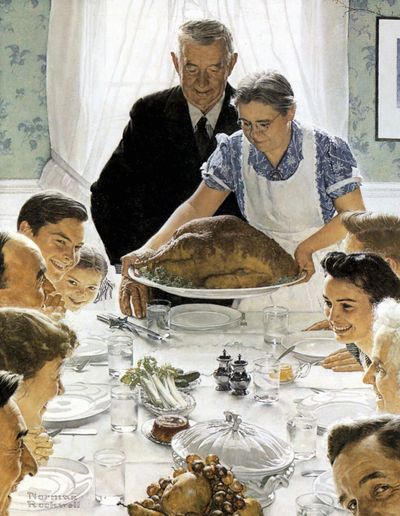Rockwell served up helping of reality in idealized scene

Right before Thanksgiving, I was standing in front of Norman Rockwell’s Thanksgiving painting.
I mean, the genuine article. This was the original oil painting, which is actually titled “Freedom From Want.” We were visiting the Norman Rockwell Museum in Stockbridge, Mass., as part of a trip to my nephew’s wedding in New England’s Berkshire Hills.
Several things struck me. The painting is much brighter and lighter than it appears in reproductions. The entire canvas is suffused with white, as if the family table were right in front of a big picture window. It made an already perfect scene look even more idyllic.
Yet for all of its much-derided sentimentality and nostalgia, it was a pretty accurate picture of the Thanksgivings I remember as a kid, and – I would like to hope – the Thanksgivings that my own children will remember. Yes, the family is better groomed and a touch more cheerful – they don’t appear to be arguing over whether the turkey was done. But the basic ingredients were the same: a big family table, everybody talking at once, the “good” salt-and-pepper shakers, the covered side dishes and Grandma and Grandpa serving a bronzed bird. It even has the show-off uncle in the corner, winking back at the “camera.”
This struck me forcefully because of something I had heard during one of the museum talks. Rockwell said he never claimed to paint the world as it really exists. He painted the world as it ought to be. That is, of course, what led people to label him as hokey and superficial. Yet artists have been creating idealized worlds in their paintings and novels and symphonies for centuries. And why shouldn’t they? If you have the imagination and the talent to create a better world than this one, I say, go for it.
But this raises a logical question. If Rockwell’s world doesn’t exist, then how can it resemble my own? The first possibility is that I am misremembering our Thanksgivings and suffusing my memories with a fake Rockwell glow.
The other possibility, the one I prefer, is that maybe, just maybe, our Thanksgivings really were perfect and idyllic. If so, I have an awful lot to be thankful for every November.
One more thing struck me as I wandered through the museum: Rockwell’s paintings were bursting with great, craggy, wrinkled, character-rich faces. This is even more evident in the other three paintings that make up his “Four Freedoms” series (the others are “Freedom of Speech,” “Freedom of Worship” and “Freedom from Fear”).
Few of Rockwell’s faces are fashion-model beautiful or even conventionally attractive. Many are old, sagging, weathered and hard-won. These faces have crow’s-feet and furrows. They have warts.
Yet Rockwell couldn’t get enough of those faces. He modeled most of them on local Stockbridge characters, and he was quoted as saying that the Old Masters would have loved to have so many great faces to paint.
So why are Americans today so afraid to let their faces show character? We’re tucking and lifting and Botoxing our faces into blank canvases. If artists, the most visually sensitive people among us, know that a weather-worn face is more interesting than a frozen mask, why can’t the rest of us figure it out?
And finally, one more thought occurred to me. Maybe Rockwell wasn’t entirely a sentimental idealist after all. In some crucial ways, he was a master at depicting the world as it actually exists – warts and all.